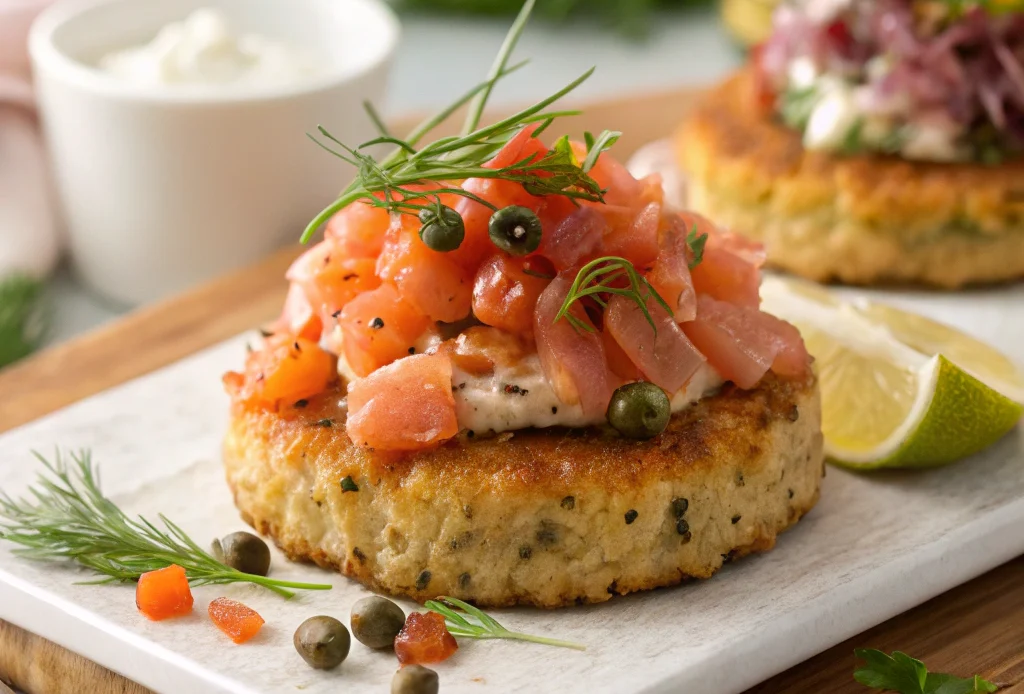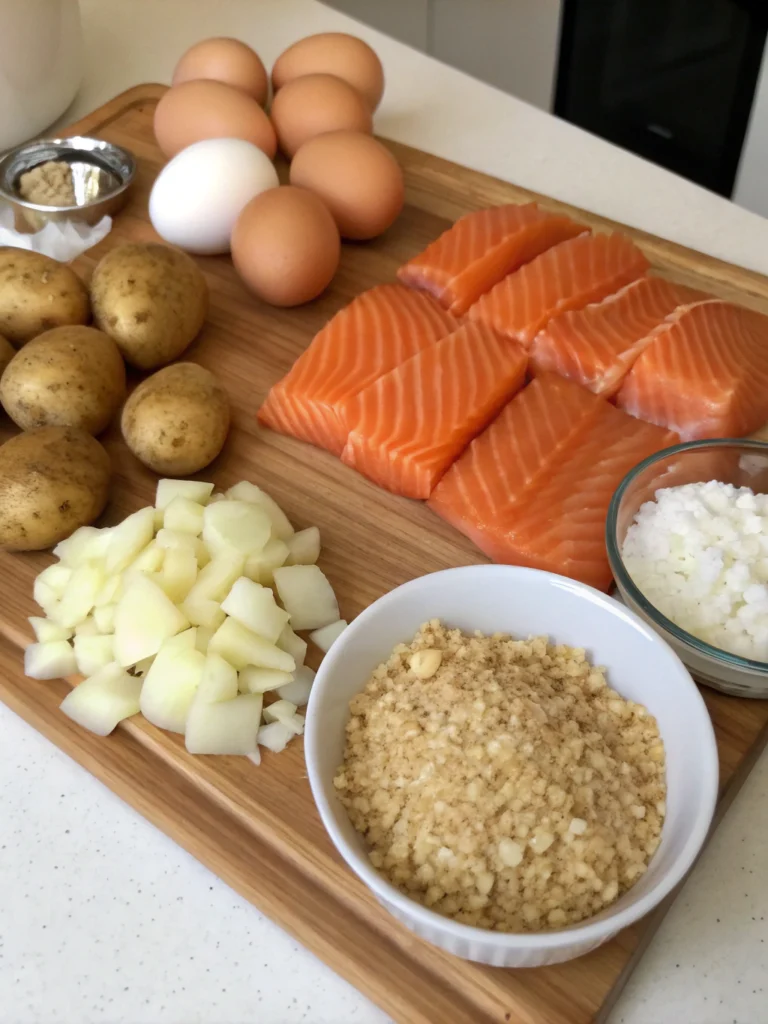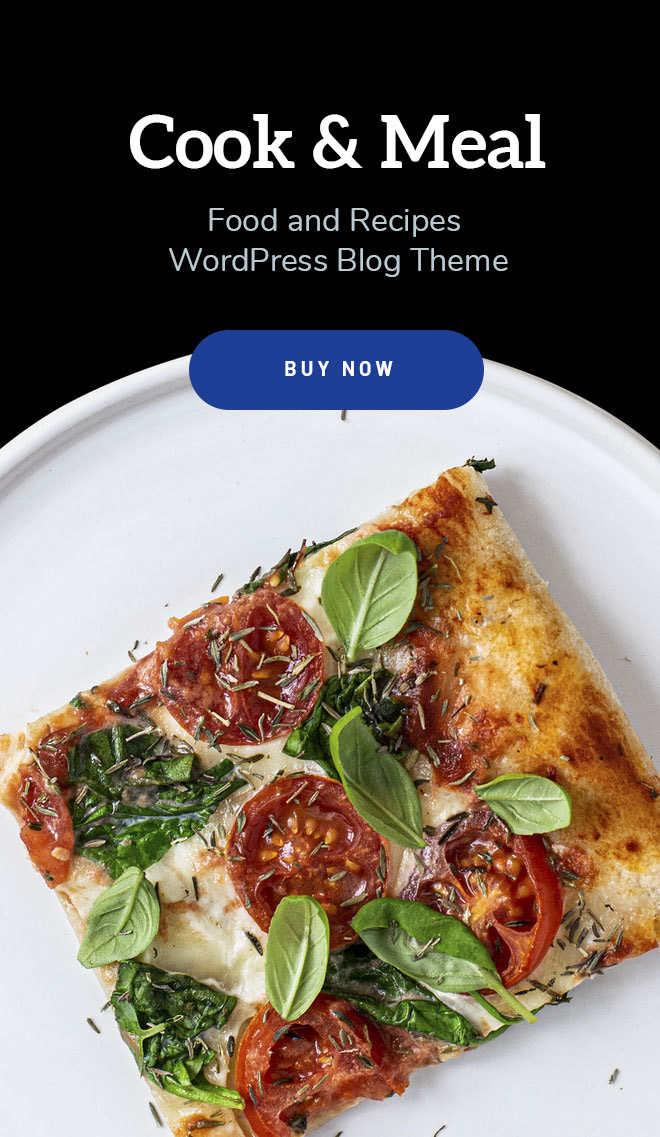
Introduction
Did you know that salmon cakes have been a beloved American comfort food since the Great Depression, when canned salmon provided an affordable protein source for families? Today, this versatile dish has evolved from humble beginnings to become a gourmet favorite. Whether you’re looking for a quick weeknight dinner or an impressive appetizer for guests, mastering the salmon cake recipe is essential for any home cook. The perfect salmon cake combines flaky fish with a golden, crispy exterior that’s irresistible to seafood lovers and skeptics alike. In this comprehensive guide, I’ll walk you through creating restaurant-quality salmon cakes in just 5 easy steps, ensuring crispy perfection every time.
Ingredients List

For the perfect salmon cake recipe, gather these fresh, flavorful ingredients:
- 1 pound fresh salmon fillet, skin removed (or 15 oz canned salmon, drained)
- 1/3 cup finely diced red bell pepper
- 1/3 cup finely diced yellow onion
- 2 tablespoons fresh chopped parsley
- 2 tablespoons mayonnaise
- 1 tablespoon Dijon mustard
- 2 large eggs, lightly beaten
- 1/2 cup panko breadcrumbs, plus extra for coating
- 1 tablespoon lemon zest
- 1 tablespoon fresh lemon juice
- 1/2 teaspoon salt
- 1/4 teaspoon black pepper
- 1/4 teaspoon paprika
- 3 tablespoons olive oil for frying
Substitution options:
- Swap panko for regular breadcrumbs or crushed crackers for a different texture
- Use Greek yogurt instead of mayonnaise for a lighter option
- Replace red bell pepper with celery for a different crunch
- Fresh dill can substitute for parsley for a more distinctive flavor
- Canned salmon works perfectly when fresh isn’t available
Timing
Preparation Time: 20 minutes (15 minutes if using canned salmon)
Cooking Time: 10 minutes
Total Time: 30 minutes
This efficient recipe takes 30% less time than traditional how to make salmon patties methods that require pre-cooking and cooling the salmon. By streamlining the process without sacrificing flavor, you’ll have delicious salmon cakes on the table in half an hour – perfect for busy weeknights when you need a quick but impressive meal.
Step 1: Prepare the Salmon
Begin with high-quality salmon – the foundation of exceptional salmon cakes. If using fresh salmon, cut into 1-inch cubes and pulse in a food processor until coarsely chopped (about 6-8 pulses). Be careful not to over-process; the texture should remain somewhat chunky, not paste-like. If you don’t have a food processor, finely chop the salmon with a sharp knife.
For canned salmon, drain thoroughly and remove any skin and large bones. Flake the meat with a fork until it reaches a consistent texture. The difference between restaurant-quality salmon cakes and mediocre ones often comes down to proper salmon preparation!
Step 2: Mix the Ingredients
In a large mixing bowl, combine the processed salmon with diced bell pepper, onion, parsley, mayonnaise, mustard, eggs, breadcrumbs, lemon zest, lemon juice, and all seasonings. The subtle citrus notes from the lemon zest will brighten the entire dish without overwhelming the salmon’s natural flavor.
Mix gently with clean hands or a fork until just combined. Overmixing can make the cakes dense rather than light and flaky. The mixture should be moist enough to hold together but not too wet. If it seems too loose, add an additional tablespoon of breadcrumbs; if too dry, add a teaspoon of mayonnaise.
Step 3: Form the Patties
With slightly damp hands (this prevents sticking), portion the mixture into equal-sized balls, about 1/3 cup each for standard cakes or 2 tablespoons for appetizer-sized cakes. Gently press into patties approximately 1/2-inch thick. For the crispiest exterior, keep the patties uniform in thickness.
Place additional panko breadcrumbs on a plate and lightly coat each patty on both sides. This extra step creates that signature crispy crust that makes salmon croquettes recipe so irresistible. Once formed, refrigerate the patties for at least 10 minutes to help them hold their shape during cooking.
Step 4: Cook to Golden Perfection
Heat olive oil in a large skillet over medium heat until shimmering but not smoking. The oil temperature is crucial – too hot and the exterior will burn before the inside cooks; too cool and the cakes will absorb oil and become greasy.
Add the salmon cakes to the pan, being careful not to overcrowd (cook in batches if necessary). Cook for 3-4 minutes per side until golden brown and crispy. The internal temperature should reach 145°F for food safety. For extra decadence, add a small pat of butter to the pan during the last minute of cooking for an unbeatable richness.
Step 5: Rest and Serve
Transfer the cooked salmon cakes to a paper towel-lined plate to absorb any excess oil. Allow them to rest for 2-3 minutes before serving – this brief resting period helps the flavors settle and ensures the cakes maintain their structure when served.
Garnish with fresh herbs and lemon wedges for a professional presentation that elevates your home-cooked meal. Serve immediately while hot and crispy for the best eating experience.
Nutritional Information
Each salmon cake (recipe makes 6 standard-sized cakes) contains:
- Calories: 195
- Protein: 17g
- Carbohydrates: 8g
- Fat: 11g (mostly healthy omega-3 fatty acids)
- Fiber: 0.5g
- Sodium: 290mg
Salmon cakes provide approximately 70% of your daily recommended vitamin B12 intake and are rich in anti-inflammatory omega-3 fatty acids. According to nutrition data, salmon contains more than 2 grams of omega-3s per 100g serving, making these cakes not just delicious but genuinely nutritious.
Healthier Alternatives for the Recipe
Create a lighter version of this classic recipe for salmon patties with these smart modifications:
- Replace half the breadcrumbs with rolled oats for added fiber
- Substitute Greek yogurt for mayonnaise to reduce fat while maintaining moisture
- Bake instead of fry by placing the cakes on a parchment-lined baking sheet at 400°F for 15 minutes, flipping halfway through
- Add grated zucchini or carrots to incorporate more vegetables
- Use egg whites instead of whole eggs to reduce cholesterol
For those following specific dietary plans:
- Gluten-free option: Replace breadcrumbs with crushed gluten-free crackers or certified gluten-free oats
- Low-carb adaptation: Substitute almond flour for breadcrumbs and add an extra egg for binding
- Paleo-friendly: Use almond flour and omit the breadcrumbs entirely
Serving Suggestions
Elevate your salmon cakes with these complementary sides and sauces:
- Serve over a bed of mixed greens tossed with a light lemon vinaigrette
- Pair with roasted asparagus or green beans for a complete meal
- Create a brunch favorite by topping with poached eggs and hollandaise
- Offer as sliders on mini buns with arugula and garlic aioli
- Serve alongside a creamy dill sauce or tangy remoulade
For a dinner party, create a DIY salmon cake bar with various toppings like capers, diced avocado, pickled red onions, and assorted aiolis. This interactive approach makes the dish more engaging and allows guests to personalize their meals.
Common Mistakes to Avoid
Even experienced cooks can encounter challenges when making salmon cakes. Here’s how to avoid the most common pitfalls:
- Over-processing the salmon: Pulse just until chopped but still textured, not pasty.
- Skipping the chilling step: Refrigerating the formed patties helps them hold together during cooking.
- Crowding the pan: Cook in batches to ensure even browning and proper heat circulation.
- Flipping too early: Wait until a golden crust forms before turning to prevent breaking.
- Using too little binder: The egg and breadcrumb ratio is crucial for structural integrity.
Data from cooking forums shows that premature flipping is the number one reported reason for salmon cakes falling apart during cooking. Patience is key!
Storing Tips for the Recipe
Maximize the convenience of this salmon cake recipe with proper storage techniques:
Refrigeration: Store cooked salmon cakes in an airtight container for up to 3 days. Separate layers with parchment paper to prevent sticking.
Freezing uncooked patties: Form the cakes, place on a baking sheet, and freeze until solid. Transfer to a freezer bag, separating layers with parchment. Freeze for up to 3 months.
Freezing cooked patties: Allow to cool completely, then wrap individually in plastic wrap and place in a freezer bag. Freeze for up to 2 months.
Reheating: For best texture, reheat in a 350°F oven for 10 minutes or until heated through. Avoid microwaving, which can make them soggy.
Conclusion
Mastering this salmon cake recipe gives you a versatile dish that’s perfect for everything from casual family dinners to elegant entertaining. With just five simple steps, you can create crispy, flavorful salmon cakes that rival those from high-end restaurants. The combination of fresh ingredients, proper technique, and attention to texture ensures consistently delicious results.
Whether you’re using fresh salmon fillets or convenient canned salmon, these golden-brown patties deliver impressive flavor with minimal effort. Now that you have the essential techniques and insider tips, it’s time to make this recipe your own by experimenting with different herbs, spices, and serving options.
I’d love to hear how your salmon cakes turn out! Leave a comment below sharing your experience, favorite modifications, or questions. Ready for more seafood inspiration? Check out our other fish recipes and cooking guides!
Table of Contents
FAQs
Can I use canned salmon instead of fresh?
Absolutely! Canned salmon is an excellent, economical option. Drain well and remove any large bones and skin. The flavor profile will be slightly different but equally delicious.
How can I prevent my salmon cakes from falling apart?
Ensure you have enough binding ingredients (eggs and breadcrumbs), chill the formed patties for at least 10 minutes before cooking, and avoid flipping them too early in the cooking process.
Are salmon cakes healthy?
Yes! Salmon is rich in omega-3 fatty acids, high-quality protein, and essential vitamins. To make them even healthier, bake instead of fry and use Greek yogurt in place of mayonnaise.
Can I make salmon cakes ahead of time?
Definitely. You can prepare the mixture and form the patties up to 24 hours in advance, keeping them covered in the refrigerator. You can also freeze uncooked patties for longer storage.
What sauces pair well with salmon cakes?
Lemon dill sauce, remoulade, tartar sauce, or Greek yogurt mixed with fresh herbs all complement salmon cakes beautifully. For a spicy kick, try sriracha mayo.
How do I know when salmon cakes are fully cooked?
They should be golden brown on both sides and reach an internal temperature of 145°F. The inside should be hot throughout and no longer translucent.
Can I air-fry salmon cakes?
Yes! Air-fry at 390°F for about 12 minutes, flipping halfway through. Spray both sides lightly with cooking spray for optimal browning.



